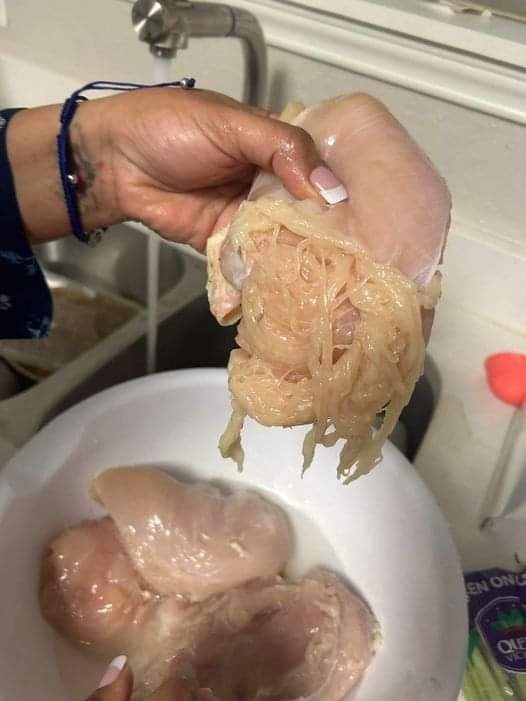ADVERTISEMENT
- Overcooking the Chicken: When chicken breast is cooked too long or at too high of a temperature, the muscle fibers begin to break down. If the chicken is overcooked, it can lose its structural integrity and become tender enough to shred easily into thin strands.
- Shredding Effect: As the chicken breast cooks, the fibers separate, much like what happens when you cook pulled pork or chicken for shredding. If the chicken breast is cooked for an extended period (especially in a moist cooking method, such as braising or boiling), the muscle fibers loosen and may pull apart in long, spaghetti-like strands.
- The Texture of the Strands: The texture of the strands can resemble pasta because of the way the chicken’s fibers split apart. The strands are thin and resemble noodles, but they’re still, of course, made from chicken.
This is not a typical cooking result, but it can happen if the chicken is subjected to certain cooking conditions. In fact, some recipes intentionally use this shredding technique, such as in pulled chicken dishes or chicken for tacos, but the “spaghetti strand” effect is usually seen more when the meat is cooked for an extended period of time in a moist environment.
Possible Causes of the Chicken “Spaghetti” Effect
There are several factors that could have caused the chicken breast to turn into spaghetti strands in this particular situation:
- Slow Cooking or Boiling: If the chicken was boiled for a long time or cooked in a slow cooker, the high heat and extended cooking time can cause the fibers in the chicken to break down. This can result in the meat becoming so tender that it shreds into thin strands that look like pasta.
- High Heat or Direct Contact with Heat Source: If the chicken was cooked in a skillet or on a grill at too high a heat, the outer layer of the chicken might cook too quickly while the inside becomes overcooked, causing the fibers to separate and form spaghetti-like strands.
- Moisture Content: Cooking chicken in a very moist environment, such as simmering it in broth or a sauce, can also lead to the fibers breaking apart more easily. The chicken’s proteins are more likely to soften and shred when exposed to moisture for an extended period of time.
- Type of Chicken Used: The specific cut of chicken could also play a role. If a particularly tender chicken breast was used, or one that had been frozen and thawed (which can affect its texture), it might have been more prone to shredding during cooking.
Can You Recreate This “Spaghetti Chicken” at Home?
While this phenomenon wasn’t an intentional recipe or kitchen hack, the result could be recreated if you’re interested in experimenting with different cooking methods. If you want to try making chicken that shreds into long, pasta-like strands, here’s how to do it:
- Boiling Method: To achieve the spaghetti strand effect, try boiling chicken breasts in a large pot of water or broth over medium-low heat for an extended period of time. After 30-40 minutes of simmering, the chicken will begin to break apart, and you’ll likely see the fibers turn into strands. Make sure to keep an eye on the chicken to prevent it from completely dissolving.
- Slow Cooker Method: Another way to get chicken to shred into strands is by using a slow cooker. Add chicken breasts to the slow cooker with your choice of seasonings, vegetables, and broth. Let it cook on low for several hours. When it’s done, you can easily shred the chicken with a fork into long, spaghetti-like strands.
- Shredding with Forks: After cooking the chicken thoroughly, simply use two forks to shred it. The more you shred, the finer and more spaghetti-like the strands will become. This works especially well if you’ve cooked the chicken in a flavorful broth or sauce.
Final Thoughts
The viral photo of the chicken breast turning into spaghetti strands may have shocked many, but there’s a simple explanation behind the kitchen mystery. While it’s not exactly a traditional cooking result, the process of chicken shredding can result in these fascinating, noodle-like strands when overcooked or cooked in a moist environment.
Whether it was a happy accident or a new cooking technique in the making, it’s clear that food can sometimes surprise us in the most unexpected ways. If you’re intrigued by this odd culinary phenomenon, consider giving it a try in your own kitchen. Who knows—you might just discover a new way to enjoy your chicken dishes!
So, the next time you’re preparing a meal, remember that even the most ordinary ingredients can yield extraordinary results. And, just maybe, you’ll create your own viral kitchen moment!
